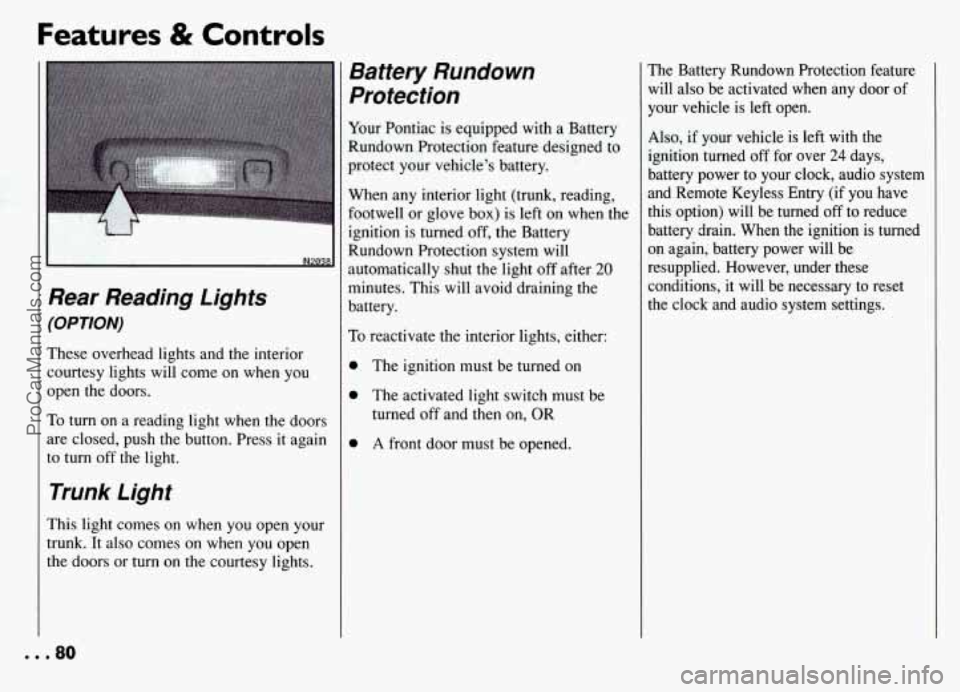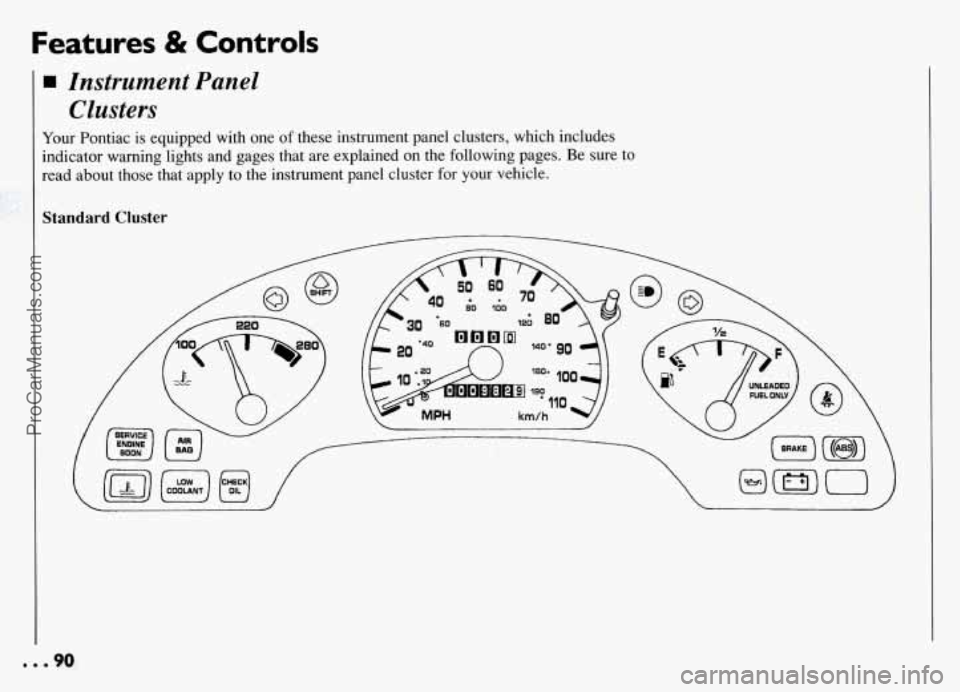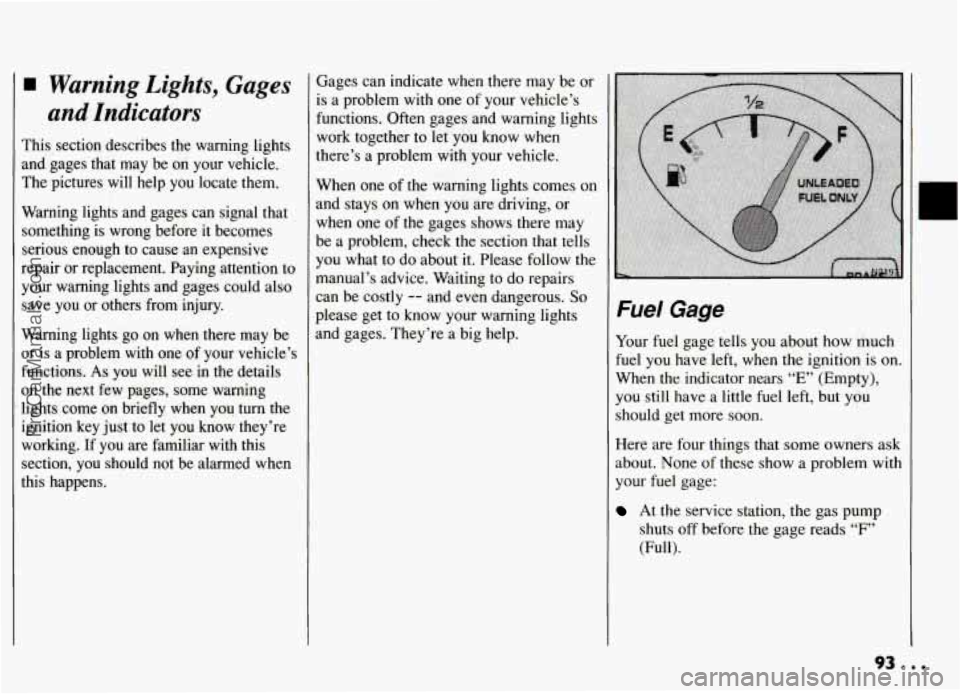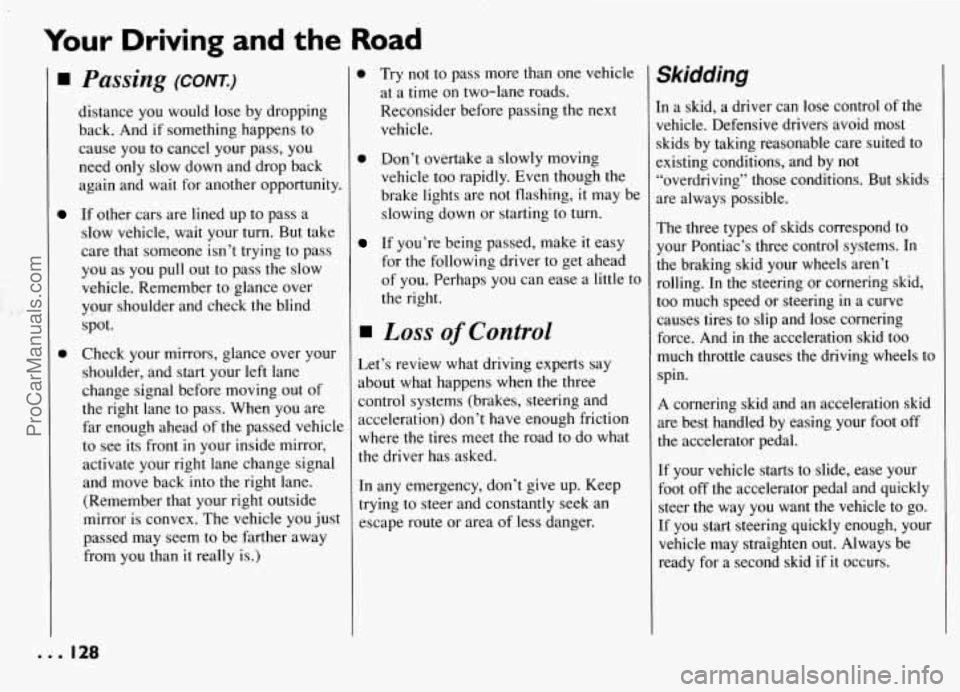1994 PONTIAC GRAND-AM lights
[x] Cancel search: lightsPage 80 of 274

Instrument Panel Intensity Control
You can brighten or dim your instrument
cluster lights by rotating the instrument
panel intensity control switch. Rotate the switch all the way to the right to turn on
the interior courtesy lights. Rotate the
switch to the left to turn
off the instrument
cluster lights and displays.
Fog Lights
The switch for your fog lights is next to
the instrument panel intensity control.
Push the top of the switch to turn the fog
lights on.
When using fog lights, the parking lights
or low beam headlights must be on.
Fog lights will go off whenever the high
beam headlights come on. When the high
beams go off, the fog lights will come on
again.
Front Reading Lights
(OPTION)
These lights and the interior courtesy
lights will come on when
you open the
doors.
To turn on a reading light when the doors
are closed, press the button. Press it again
to turn the light off.
79.8.
ProCarManuals.com
Page 81 of 274

Features & Controls
Rear Reading Lights
(OPTION)
These overhead lights and the interior courtesy lights will come on when you
open the doors.
To turn on a reading light when the doors
are closed, push the button. Press it again
to turn
off the light.
Trunk Light
This light comes on when you open your
trunk. It also comes on when you open
the doors or
turn on the courtesy lights.
Battery Rundown
Protection
Your Pontiac is equipped with a Battery
Rundown Protection feature designed to
protect your vehicle's battery.
When any interior light (trunk, reading,
footwell or glove
box) is left on when the
ignition is turned
off, the Battery
Rundown Protection system will
automatically shut the light
off after 20
minutes. This will avoid draining the
battery.
To reactivate the interior lights, either:
0 The ignition must be turned on
0 The activated light switch must be
turned off and then on, OR
0 A front door must be opened.
The Battery Rundown Protection feature
will also be activated when any door of
your vehicle is left open.
Also, if your vehicle is left with the
ignition turned
off for over 24 days,
battery power to your clock, audio system
and Remote Keyless Entry (if you have
this option) will be turned
off to reduce
battery drain. When
the ignition is turned
on again, battery power will be
resupplied. However, under these
conditions, it will be necessary to reset
the clock and audio system settings.
... 80
ProCarManuals.com
Page 84 of 274

H Inside Manual
DaylNight Rearview
Mirror
To reduce glare from lights behind you,
move the lever toward you to the night
1 Convex Outside Mirror
our right side mirror is convex.
convex mirror’s surface is curved so
ou can see more from the driver’s seat.
H Manual Remote
Control Mirrors
The outside rearview mirrors should be
adjusted
so you can just see the side of
your vehicle when
you are sitting in a
comfortable driving position.
Adjust the driver side outside mirror with
the control lever on the driver’s door.
To adjust your passenger side mirror, sit
in the driver’s seat and have a passenger
adjust the mirror for you.
83...
ProCarManuals.com
Page 90 of 274

The Instrument
Panel-Your Information System
Your instrument panel is designed to let
you know at a glance how
your vehicle is
running. You’ll know how fast you’re
going, how much fuel you’re using, and
many other things you’ll need to drive
safely and economically.
The main components of your instrument
panel are:
1. Fog Light Switch
2. Instrument Panel Intensity Control,’
Interior Lights Switch
3. Side Vent
4. Turn Signal/Multifunction Lever
5. Hazard Warning Flashers Switch
6. Instrument Cluster
7. Windshield Wipersmasher Stalk
8. Center Vent
9. Audio System
10. Side Vent
11. Side Window Defogger Vent
12. Glove Box
13. Climate Control System
14. Ashtraybighter
15. Gear Shift Lever
16. Rear Window Defogger (Option)
17. Ignition Switch
18. SRS - Supplemental Restraint
System (Air Bag)
19. Horns
20. Tilt Steering Wheel Lever (Option)
21. Parking Brake Release Lever
22. Hood Release Handle
23. Fuse Panel
ProCarManuals.com
Page 91 of 274

Features & Controls
Instrument Panel Clusters
Your Pontiac is equipped with one of these instrument panel clusters, which includes
indicator warning lights and gages that are explained on the foilowing pages. Be sure to
read about those that apply to the instrument panel cluster for your vehicle.
Standard Cluster
... 90
ProCarManuals.com
Page 94 of 274

Warning Lights, Gages
and Indicators
This section describes the warning lights
and gages that may be on your vehicle. The pictures will help you locate them.
Warning lights and gages can signal that
something is wroug before it becomes
serious enough to cause an expensive
repair or replacement. Paying attention to
your warning lights and gages could also
save you
or others from injury.
Warning lights go on when there may be
Dr is a problem with one of your vehicle’s
functions. As you will see
in the details
on the next few pages, some warning
lights come on briefly
when you turn the
ignition key just to let you know they’re
working. If you are familiar with this
section, you should not be alarmed when
this happens.
Gages can indicate when there may be or
is a problem with one of your vehicle’s
functions. Often gages and warning lights
work together to let you know when
there’s a problem with your vehicle.
When one of the warning lights comes on
and stays on when you are driving, or
when one of the gages shows there may
be a problem, check the section that tells
you what to do about
it. Please follow the
manual’s advice. Waiting to do repairs
can
be costly -- and even dangerous. So
please get to know your warning lights
and gages. They’re
a big help.
Fuel Gage
Your fuel gage tells you about how much
fuel you have left, when the ignition is on.
When
the indicator nears “E” (Empty),
you still have a little
fuel left, but you
should get more soon.
Here are four things that some owners ask
about. None of these show a problem with
your fuel gage:
At the service station, the gas pump
shuts off before the gage reads “F”
(Full).
c
93...
ProCarManuals.com
Page 129 of 274

Your Driving and the Road
I
0
Passing (CONT.)
distance you would lose by dropping
back. And if something happens to
cause you to cancel your pass, you
need only slow down and drop back
again and wait for another opportunity.
If other cars are lined up to pass a
slow vehicle, wait your turn. But take
care that someone isn’t trying to pass
you as you pull out to pass the slow
vehicle. Remember to glance over
your shoulder and check the blind
spot.
Check your mirrors, glance over your
shoulder, and start your left lane
change signal before moving out of
the right lane to pass. When you are
far enough ahead of the passed vehicle
to see its front
in your inside mirror,
activate your right lane change signal
and move back into the right lane.
(Remember that your right outside
mirror is convex. The vehicle you just
passed may seem to be farther away
from you than
it really is.)
B Try not to pass more than one vehicle
at a time on two-lane roads.
Reconsider before passing the next
vehicle.
B Don’t overtake a slowly moving
vehicle too rapidly. Even though the
brake lights are not flashing, it may be
slowing down or starting to
turn.
If you’re being passed, make it easy
for the following driver to get ahead
of you. Perhaps you can ease a
little to
the right.
Loss of Control
Let’s review what driving experts say
about what happens when the three
control systems (brakes, steering and
acceleration) don’t have enough friction
where the tires meet
the road to do what
the driver has asked.
In any emergency, don’t give up. Keep
trying to steer and constantly seek an
escape route or area of less danger.
Skidding
[n a skid, a driver can lose control of the
vehicle. Defensive drivers avoid most
skids by taking reasonable care suited to
:xisting conditions, and by not
,‘overdriving” those conditions. But skids
we always possible.
The three types of skids correspond to
your Pontiac’s three control systems. In
the braking skid your wheels aren’t
rolling. In the steering or cornering skid,
too much speed or steering in a curve
causes’tires to slip and lose cornering
force. And in the acceleration skid too
much throttle causes the driving wheels to
spin.
A cornering skid and an acceleration skid
are best handled by easing your foot off
the accelerator pedal.
If your vehicle starts to slide, ease your
foot off the accelerator pedal and quickly
steer the way you want the vehicle to go.
If you start steering quickly enough, your
vehicle may straighten out. Always be
ready for a second skid if
it occurs.
... 128
ProCarManuals.com
Page 130 of 274

Of course, traction is reduced when water, I
snow, ice, gravel, or other material is on
the road. For safety, you’ll want to slow
down and adjust your driving to these conditions. It is important to slow down
on slippery surfaces because stopping
distance will be longer and vehicle
control more limited.
While driving on a surface with reduced traction, try your best to avoid sudden
steering, acceleration, or braking
(including engine braking by shifting to a
lower gear). Any sudden changes could cause the tires to slide.
You may not?
realize the surface is slippery until your
vehicle is skidding. Learn to recognize
warning clues
-- such as enough water;
ice or packed snow on the road to make a
“mirrored surface”
-- and slow down
when you have any doubt.
Remember: Any anti-lock braking system (ABS) helps avoid only the braking skid.
I
Driving at Night
Night driving is more dangerous than day
driving. One reason is that some drivers
are likely to be impaired
-- by alcohol or
drugs, with night vision problems, or by
fatigue.
Here are some tips on night driving.
Drive defensively.
0 Don’t drink and drive.
Adjust your inside rearview mirror to
reduce the glare from headlights
behind you.
0 Since you can’t see as well, you may
need to slow down and keep more
space between you and other vehicles.
0 Slow down, especially on higher
speed roads. Your headlights can light
up only
so much road ahead.
In remote areas, watch for animals.
If you’re tired, pull off the mad in a
safe place and rest.
Night Wsion
No one can see as well at night as in the
daytime. But as we get older these
differences increase. A 50-year-old driver
may require at least twice as much. light to
see the same thing at night as a
20-year-old.
What you do in the daytime can also
affect your night vision. For example, if
you spend the day
in bright sunshine you
are wise to wear sunglasses. Your eyes
will have less trouble adjusting to night.
But
if you’re driving, don’t wear
sunglasses at night. They may cut down
on glare from headlights, but they also
make a lot of things invisible.
129...
ProCarManuals.com